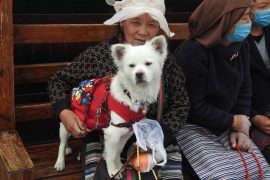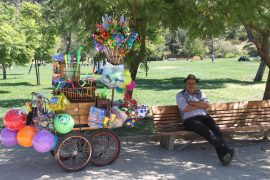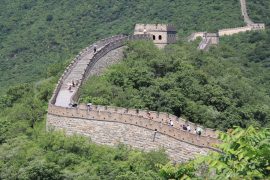AT first, as the bright, late-afternoon sun plays on the craggy hillsides and bleached boulders, it is hard to make out the horses, so well do they blend in.
Then gradually, as our eyes adjust to the sharp shadows, we can see them, a herd of about 40, several of the mares with foals by their sides.
These are Przewalski’s horses — takhi, the Mongolians call the breed — that were once thought extinct. But they are now back in the wild, thanks to an international conservation program.
They are rather distinctive, with a chunky neck and body, honey-coloured coat, short spiky black mane, black legs and tail, and pale muzzle and stomach. The takhi is a living link to the prehistoric past and the forerunner of the domestic horse.
The creatures are not frightened, just cautious, and keep their distance as they slowly continue on their path parallel to us, the half dozen or so foals continually nudged protectively into the middle of the group, the dominant stallion trotting backwards and forwards, chivvying his harem.
Horses have long roamed the spectacular but harsh terrain of the steppes but it was the Mongol leader Genghis Khan who cemented their place in his country’s history. He forged the disparate nomadic Mongol tribes into an all-conquering force, with the diminutive domesticated horse as his secret weapon.
Mounted on the small but amazingly sturdy horses and armed with bows, which they shot with deadly accuracy while standing high in the stirrups, his hordes carried out lightning raids and then returned to the steppes.
The largely agricultural communities they targeted were no match for the ferocious hit-and-run tactics and, at the height of Genghis’s power, his forces had conquered the land from Korea to Hungary, Russia to modern Vietnam and Syria. He had become khan of all between the oceans.
There are about 250 takhi thriving in the Hustai National Park, about 100km southwest of the capital, Ulaanbaatar, a trip that takes you through awesome countryside and a great deal of genuinely teeth-rattling roads and tracks. The 50,000ha park was declared a Special Protection Area in 1993 specifically to house the horses. But it is also critical to protect the endangered ecosystem of the area. In summer the vast grasslands are carpeted with a dazzling variety of delicate wildflowers and home to animals such as deers, gazelles and marmots, as well as the elusive but predatory wolves and lynxes.
Since the arrival of democracy in the 1990s the park has been strongly supported by the government, conscious not just of the place the takhi has in the hearts of Mongolians but of the importance of protecting the ecosystem.
Most visitors stay at the Hustai eco camp, a collection of traditional gers spread like large white mushrooms across the hillside. The round felt and canvas tents are basic but colourful and comfortable, and are warm on even the coldest nights (and the nights get pretty chilly) with the wood-burning stoves pumping out heat.
Guests take their meals together in the largest ger and there are clean communal shower and toilet facilities; like most ger camps in Mongolia, though, the hot showers can be a bit of a lottery and food is fairly basic. There’s also a ger housing the takhi information centre.
A team of highly educated and enthusiastic Mongolian staff manages the park and conducts scientific research to ensure the takhi, as well as the other unique flora and fauna, will continue to thrive. As well as the usual tourists there are growing numbers of eco-volunteers attending three-week conservation programs.
The reintroduction of the takhi was a small miracle. The last lone wild horse was spotted in Mongolia in 1969 and shortly afterwards was declared extinct in the wild, forced into oblivion by poaching, and over-grazing by domestic livestock.
However, a small number of takhi were living in zoos in The Netherlands, Switzerland, Germany and Australia, which collaborated on a breeding program that enabled a strong enough genetic base to build a new population.Once two generations of selected horses had been established, they were taken to a semi-wild area in Europe to relearn their natural social behaviour (including herding to protect themselves against predators such as wolves), and then were gradually reintroduced into Mongolia. Inevitably, this nation is slowly becoming more urbanised. Even so, the majority of the population, particularly in the remote areas, is still nomadic, living in small ger encampments, the ubiquitous satellite dishes and solar panels their concession to the modern communication age.
But it’s impossible to over-emphasise the place that the horse holds in the lives of the Mongolians. The wind horse (or treasured steed) is on the national coat of arms and on the tail of MIAT, the national airline. Almost from birth, children ride the sure-footed descendants of the takhi. The Mongolians are passionate about horseracing, and at the colourful annual Naadam festival, the child jockeys race their mounts over rough routes of up to 30km; the winner becomes a national celebrity. And even as motorcycles and cars grow in popularity, it’s not uncommon to be miles from any obvious sign of habitation and see a lone rider in the distance.
In a world where species are disappearing at a staggering rate, the sight of the takhi, each foal testimony to the effectiveness of the international force that was marshalled to ensure these equine missing links weren’t lost forever, takes your breath away







Comments are closed.